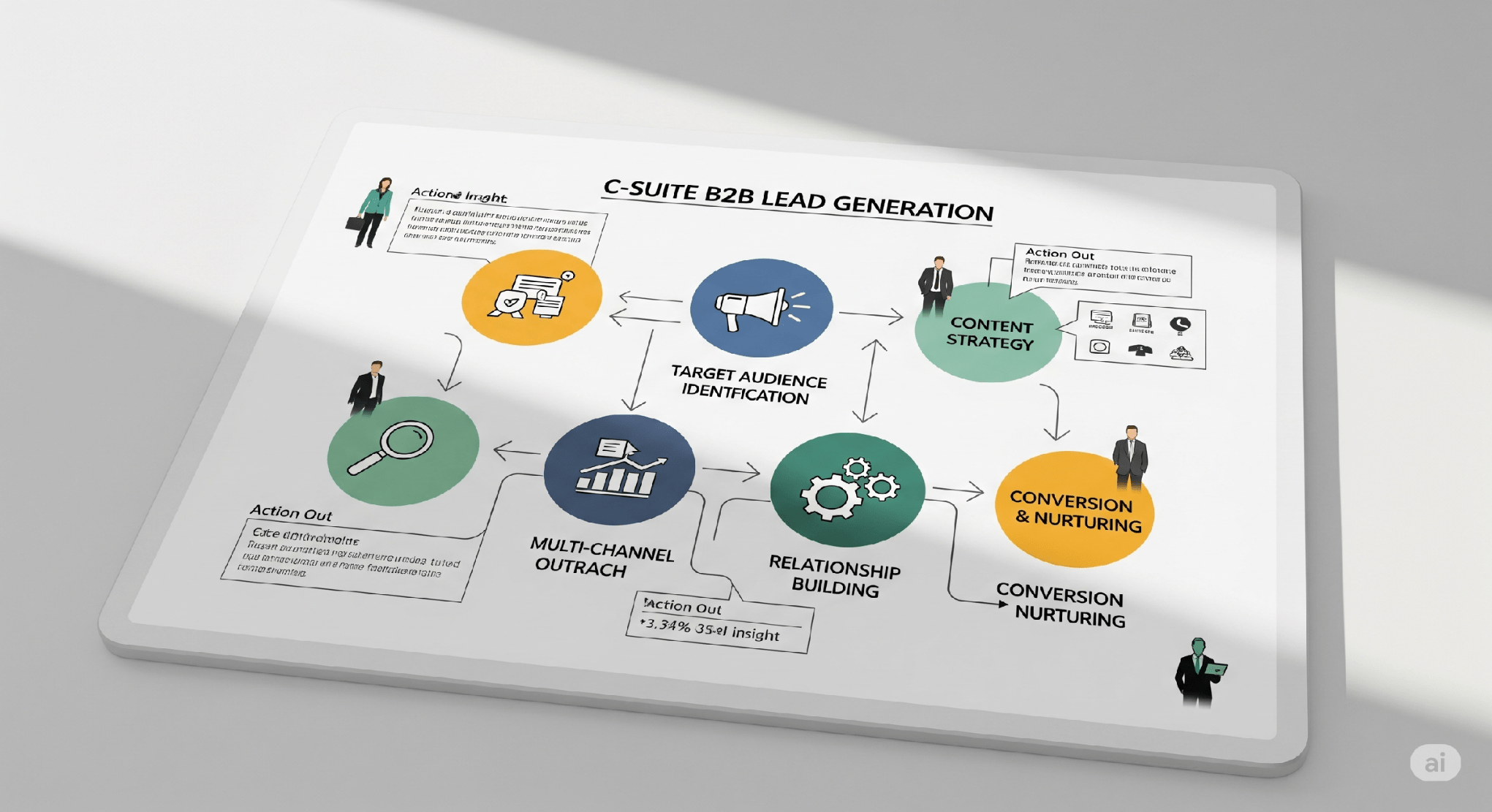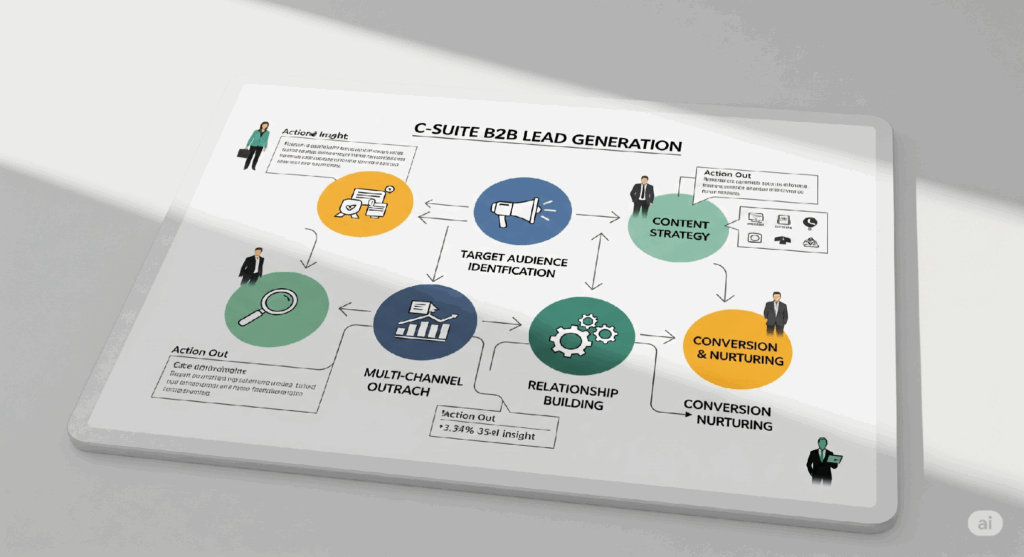This post is also available in:
You have a high-ticket B2B service that can transform a company. You know that if you could just get 15 minutes with the CEO, you could close the deal. The common advice you hear from every corner of the internet? “Just run a Video Sales Letter (VSL) funnel! It’s automated, it’s scalable, it prints money!”
So you try it. You spend a small fortune on ads, pointing them to a slickly produced video. The result? A flood of low-level managers, consultants, and job-seekers. The few executives who do click through drop off within seconds. Your calendar remains empty, and your frustration grows.
Let’s be honest: the traditional, high-pressure VSL funnel, designed for mass-market courses, is fundamentally broken for engaging the C-suite.
Why? Because CEOs, founders, and board members don’t respond to funnels; they respond to relationships, authority, and undeniable value delivered before you ever ask for a meeting. They are the most time-poor, heavily-gatekept, and marketing-skeptical audience on the planet.
The solution isn’t to abandon the VSL entirely. It’s a powerful tool when used correctly. The key is to stop using it as a battering ram at the top of your funnel and instead reposition it as the final, persuasive step in a much larger, more sophisticated ecosystem.
This is the C-Suite Engagement Blueprint: a multi-layered strategy designed to build trust, establish authority, and make high-level executives want to take your call, regardless of whether you sell consulting, enterprise software, or elite professional services.
The Foundational Flaw: Why Cold VSLs Alienate the C-Suite
Before we build the blueprint, we must understand why the standard approach fails. A C-level executive’s decision-making process is governed by two factors: trust and time. A cold VSL violates both.
- It Triggers Pattern Recognition: Executives have seen this movie before. The “secret” revealed in a video, the countdown timer, the exaggerated value stack—it screams “mass-market pitch,” not “peer-level strategic discussion.” They immediately classify it as something to be ignored.
- It Demands Time Without Proving Value: A VSL asks for 15, 30, or even 60 minutes of their most precious asset—their time—based on nothing more than a flashy ad. This is a non-starter. You must give value first, in a format they respect, before you can ask for their attention.
- It Lacks Personalization and Authority: A one-to-many video can’t possibly speak to the unique, nuanced challenges of a specific CEO or their industry. It feels generic. More importantly, it hasn’t been preceded by the signals of trust they look for: peer validation, industry recognition, and genuine thought leadership.
To successfully engage this audience, you must flip the script. Instead of leading with a sales pitch, you must lead with authority.
The C-Suite Engagement Blueprint: A 3-Pillar Framework
This blueprint is built on three pillars that work in sequence to transform you from an unknown vendor into a trusted advisor.
Pillar 1: Authority Architecture (Building the Unshakeable Foundation)
This is the most critical and often-skipped phase. Before you even think about traffic or funnels, you must architect a digital presence that commands respect.
1. The “Attractive Character” Reimagined: The CEO as the Trusted Advisor
Russell Brunson’s concept of the “Attractive Character” is brilliant, but for the C-suite, it needs a serious upgrade. They aren’t looking for a charismatic guru; they are looking for a proven leader, a strategic peer.
- Your CEO is the Brand: For any high-ticket B2B service, the face of the company must be the brand. Their LinkedIn profile, their posts, their public statements—they are the primary marketing assets.
- Actionable Step: Transform the CEO’s LinkedIn profile from a resume into a resource hub. It should feature a clear value proposition (“Helping Visionary Companies Solve [X Critical Problem]”), links to high-value content, and regular posts that offer a strong, data-backed point of view on the industry.
2. Your Digital Flagship: The Pillar Content
You need a single, high-value asset that serves as the cornerstone of your entire strategy. This is not a flimsy ebook. It’s a deep, data-rich piece of content that your target audience would willingly pay for.
- Examples for Different High-Ticket B2B Businesses:
- For an Executive Recruiter: “The 2025 UAE [Use your target area] Tech Talent Report: A Comprehensive Analysis of Salary Benchmarks, In-Demand Skills, and Hiring Trends.”
- For an Online Business School: “The Future of Executive Education: A CEO’s Guide to Upskilling Leadership in the AI Era.”
- For a Strategy Consulting Firm: “Market Entry Blueprint: A Playbook for European Firms Expanding into the Middle East.”
- For an Enterprise SaaS Company: “The Total Economic Impact of [Your Software Category]: A CFO’s Framework for Calculating ROI and Driving Adoption.”
- Actionable Step: Commit to creating one piece of pillar content per quarter. This asset will be the primary “bait” or “offer” in your initial engagement campaigns, used to capture the interest of your ideal clients.
Pillar 2: The Trust Funnel (Nurturing Relationships at Scale)
With your authority foundation in place, you can now begin to attract and nurture your ideal clients. This is not about blasting ads; it’s about strategic, value-first engagement.
1. The “Dream 100” for the Boardroom
Adapting another Brunson classic, your “Dream 100” isn’t just about influencers. It’s a curated list of the platforms and people your target C-suite already trusts.
- Identify Key Platforms: Where do your target founders and CEOs get their information? Think Forbes, Harvard Business Review, specific industry publications, and high-profile podcasts.
- Identify Key People: List the top 100 target companies you want to work with. Map out their leadership teams on LinkedIn.
- Identify Key Partners: Which non-competing businesses serve the same clients? (e.g., VC firms, M&A advisory firms, corporate law firms).
- Actionable Step: Build your Dream 100 list. Your goal is to get your pillar content and your CEO’s insights featured on these platforms and in front of these people through strategic outreach, PR, and paid promotion.
2. The Hook-Story-Offer Framework for Executives
Every piece of content you create, from a LinkedIn ad to a post, must follow this sequence, but tailored for a sophisticated palate.
- The Hook: Don’t use clickbait. Use a startling statistic from your pillar content, a provocative question, or a contrarian viewpoint.
- Example: “Our latest report shows 72% of digital transformation projects fail to deliver their expected ROI. The reason isn’t technology.”
- The Story: This is not your personal rags-to-riches story. It’s a concise, relevant case study or an “Epiphany Bridge” story that demonstrates your understanding of their problem.
- Example: “We worked with a FTSE 250 company facing this exact issue. By implementing our [Proprietary Framework], they unlocked an additional 12% in operational efficiency within six months.”
- The Offer: The offer is never “Book a Call.” The initial offer is always more of the high-value content.
- Example: “Download our full ‘Digital Transformation ROI Report’ to see the other four common pitfalls and the data-backed solutions.”
Pillar 3: The Conversion Engine (Positioning the VSL for the Close)
Only now, after a prospect has engaged with your content, trusts your CEO’s authority, and has willingly given you their contact information in exchange for value, do you introduce the VSL.
The VSL is not for cold traffic. It is a mid-funnel asset for warm, educated leads.
Its purpose is to take a lead who is problem-aware and make them solution-aware, specifically positioning your service as the only logical solution.
1. The “Perfect Webinar” as a VSL Framework
Structure your VSL using Brunson’s “Perfect Webinar” script. It’s a masterclass in persuasion.
- The Big Domino: Identify the single belief you must make your prospect believe for all their objections to fall away.
- Example Big Domino: “The only way to guarantee [The Desired Outcome] in today’s market is to implement a [Your Proprietary Framework], not just rely on traditional methods.”
- The Three Secrets: These are three stories or case studies that break the false beliefs they currently hold.
- Secret 1 (Breaks “I can do it myself”): “Why your internal team, despite being talented, lacks the specialized framework to solve this specific, high-stakes problem.”
- Secret 2 (Breaks “I can use any provider”): “The ‘Insider’s Advantage’ that generic consultants or platforms will never have.”
- Secret 3 (Breaks “It’s too expensive/risky”): “How our performance-based/phased model de-risks your investment and guarantees a measurable outcome.”
- The Stack & Close: This is where you present your offer, stacking the value of each component of your service. At the end, the call to action is finally “Book a Strategic Call” to discuss how this framework can be applied to their specific business.
Optimizing the Blueprint for the AI Search Era
This entire strategy is inherently optimized for the new world of AI-powered search (Google’s SGE, Perplexity, etc.) and social search.
- E-E-A-T on Steroids: AI search engines prioritize Experience, Expertise, Authoritativeness, and Trustworthiness. A strategy built on a CEO’s personal brand and deep, data-driven pillar content is the ultimate E-E-A-T signal.
- Entity-Based SEO: Google no longer just sees keywords; it sees entities. Your CEO becomes an entity connected to your company, which is connected to the topic of “[Your Core Service] for enterprises.” This creates a powerful, interconnected web of authority.
- Answering Conversational Queries: Your pillar content and blog posts should be structured to directly answer the complex questions CEOs are asking, like: “What is the ROI of executive leadership training?” or “How to improve supply chain efficiency?” This makes your content prime for being featured in AI Overviews.
Putting It All Together: A 90-Day Action Plan
This isn’t theoretical. Here is a tangible roadmap.
- Days 1-30: Authority Foundation.
- Finalize your ideal C-suite client persona.
- Completely overhaul the CEO’s LinkedIn profile.
- Outline and begin research for your first Pillar Content asset.
- Build your “Dream 100” list.
- Days 31-60: Trust Funnel Activation.
- Publish your Pillar Content and create a dedicated landing page.
- Launch highly targeted LinkedIn ad campaigns promoting the Pillar Content to your Dream 100 companies.
- Begin a consistent content schedule on the CEO’s LinkedIn, using the Hook-Story-Offer framework.
- Days 61-90: Conversion Engine & Optimization.
- Script and produce your mid-funnel VSL based on the “Perfect Webinar” framework.
- Set up an automated email sequence that invites leads who downloaded the Pillar Content to watch the VSL.
- Implement a system to track leads and book qualified strategy calls.
Conclusion: Stop Pitching, Start Leading
The reason high-ticket B2B lead generation feels so difficult is that most are using the wrong map. They are trying to apply mass-market tactics to a bespoke, relationship-driven world.
By shifting your mindset from “funneling” to “building authority,” you change the entire dynamic. You are no longer a vendor chasing a client; you are a leader in your industry inviting peers to a strategic conversation. The VSL becomes what it was always meant to be: not a cold opening line, but a powerful closing argument in a conversation you’ve already earned the right to have.
This blueprint requires more upfront work than a simple VSL funnel, but the rewards are exponentially greater: fewer, higher-quality leads, shorter sales cycles, and clients who see you as an indispensable partner, not just another service provider.
Now, I turn it over to you. What is the single biggest challenge you face when trying to connect with executive decision-makers? Let me know in the comments below.

